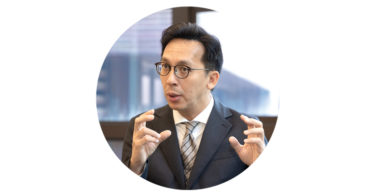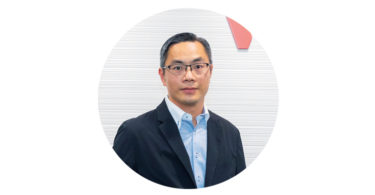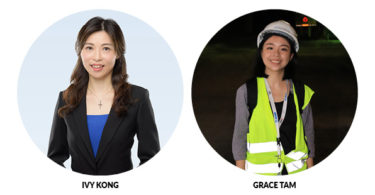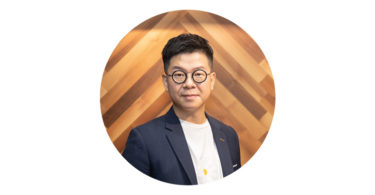Patrik Schumacher is the principal of Zaha Hadid Architects and is leading the firm since Zaha Hadid’s passing in April 2016. Viviana Muscettola (VM), Associate Director at Zaha Hadid Architects (ZHA), is currently the project director for the City of Dreams hotel project in Macau. William Cornish (WC) is Vice President of Construction for Melco Crown Entertainment (MCE), which owns the Morpheus hotel at the City of Dreams, Macau. City of Dreams is an integrated entertainment resort located in the heart of Cotai in Macau. Morpheus is the new hotel brand created and developed by Melco International Development Limited as the flagship hotel for the City of Dreams complex.
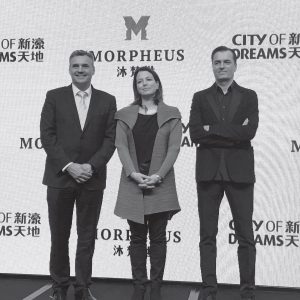 One of the revolutionary breakthroughs of Morpheus is that it is supported by a free-form exoskeleton steel structure. What are the reasons that made you take this approach?
One of the revolutionary breakthroughs of Morpheus is that it is supported by a free-form exoskeleton steel structure. What are the reasons that made you take this approach?
VM: Morpheus is designed as a sculptural element, mysterious and intriguing. Its composition does not reference traditional architectural typologies. A simple volume is carved by a series of voids to create a complex form; the holes create a distinctive appearance and offer opportunities for exciting internal spaces. The underlying diagram is of two towers connected at the podium levels and the roof, with two additional bridges from which the external voids will be experienced from within the building.
A monolithic block was extruded from the rectangular outline of the site, where the sculpted voids create a blend of roof walls and ceilings without traditional architectural elements. The expressed structure defines a sensuous and intriguing form while providing the construction advantage of contributing to the building’s lateral stability, and reducing the internal structural requirements to optimise the interior layout.
The structural mesh also contributes to define the overall free-form volume—by enveloping the glazing in a mesh of structural members and nodes, the design of the tower with the three voids in the middle section is highly reinforced. The volume is emphasised with the use of an exposed exoskeleton mesh structure, where the definition of the building itself is pushed towards its boundaries.
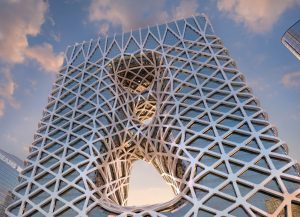 Steel was selected as the main material for the façade—how did you select the steel material supplier?
Steel was selected as the main material for the façade—how did you select the steel material supplier?
WC: The members and nodes that form the exoskeleton are curved and twisted in shape to achieve the designed architectural form. Steel was the most appropriate material as it can be heated and bent to form curved members and it can be cut and welded to form complicated node shapes. Using steel gave us the opportunity to prefabricate all the complicated structural components off-site, thus making on-site construction easier and faster. We wanted to find a steel fabricator that had a large steel factory close to Macau, one that had the necessary equipment to handle the fabrication of large steel elements. We selected the ship building company GSI and their parent company COMECO to fabricate the 28,000 tonnes of steel, and they successfully completed the task in less than 18 months.
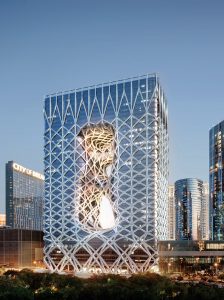 Morpheus is the first free-form exoskeleton high-rise hotel complex in the world. How did your team overcome the challenges encountered during the design process?
Morpheus is the first free-form exoskeleton high-rise hotel complex in the world. How did your team overcome the challenges encountered during the design process?
VM: The building features three sky bridges, five different glazing systems, and a non-repetitive doubly curved aluminium cladding on the exoskeleton, all within one coherent building envelope. The challenges from the formal and structural complexities and stringent performance criteria for users’ comfort are unprecedented.
The challenge of designing a multiprogramming tower and its subsequent construction in a very tight time frame confronts the limitation of human production of information. ZHA looked at implementing the traditional BIM model not only to retain different layers of inputs from different consultants, but to also transform it into a system that communicates exchanges and recalibrates the output every time the parameters are modified. The essence was to allow the different parties—clients, designers, engineers and contractors—to implement, change and recombine the data to create an always up-to-date set of output (drawing, measurements, etc.) that can reflect the current status of the project at any time.
For the façade of the main iconic area of Morpheus, the main contractor appointed four different façade contractors. ZHA has since set up a rigorous platform for collaboration amongst the designer teams. Performance, geometric and aesthetical inputs and their regulated interactions formed the instruction that guarantees the integrity of the design solution.
The support of MCE’s senior management and their execution team to develop the design from ZHA was clear with the selection of the engineering team for structure and façade—BuroHappold Engineering, London/Hong Kong—and at a later stage, the selection of the main contractor—Bouygues/Dragages, Hong Kong.
Five different contractors carried out the fabrication and final details of the façade of Morpheus. Working across different time zones allowed a 24-hour effort that was a real bonus for the project. Workshops alternating between Macau, London, Belgium (Kyotec), Shenzhen area (Hachley, Front and Jhango) and almost daily videoconferences allowed the team to work at great speed and be in constant communication despite the physical distance.
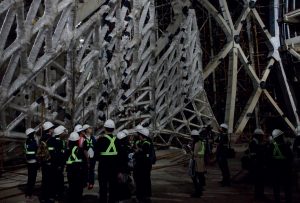 What are the distinguishing features of Morpheus that help it to stand out from other hotels in this highly competitive market?
What are the distinguishing features of Morpheus that help it to stand out from other hotels in this highly competitive market?
WC: Morpheus is an exceptional hotel both in terms of architecture and space planning. The lobby and bridge connections between the voids provide guests with remarkable experiences where they will be immersed in the building architecture whilst enjoying the luxury facilities and dining options. The guest rooms have been designed to create a hedonistic experience—the rooms have simple, yet stunning interior finishes and are each equipped with a generous-sized spa-style bathroom.
In Greek mythology, Morpheus is a god of dreams. It is mentioned that Morpheus is designed to “satisfy the dreams of tomorrow’s most sophisticated international travellers”—is it also a dream for you as a developer and a designer?
WC: As a developer, MCE was challenged by the architectural vision of ZHA. We knew that we needed to assemble a team of experts to take on the challenge and that they would need to extend their capabilities and use the most advanced and sophisticated computer software to model, analyse and design the structure and façades. We have coordinated the efforts of our consultants and contractors and their efforts have resulted in what we consider to be a first-class delivery of probably the most complicated architectural and engineering building in the region.
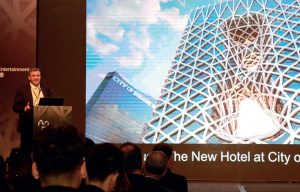 How does it set the standard for the new kind of contemporary hotels in the future? What kind of impact do you hope to make on the leisure and entertainment sector?
How does it set the standard for the new kind of contemporary hotels in the future? What kind of impact do you hope to make on the leisure and entertainment sector?
WC: It is our hope that Morpheus will herald the start of a new standard in luxury guest experience. The building has raised the bar in terms of what can be achieved in architecture and engineering for new buildings in Macau and the region. Soon, guests will be able to enjoy the luxury services and facilities for themselves.

 Malaysia
Malaysia Singapore
Singapore Indonesia
Indonesia Tiếng Việt
Tiếng Việt ประเทศไทย
ประเทศไทย





